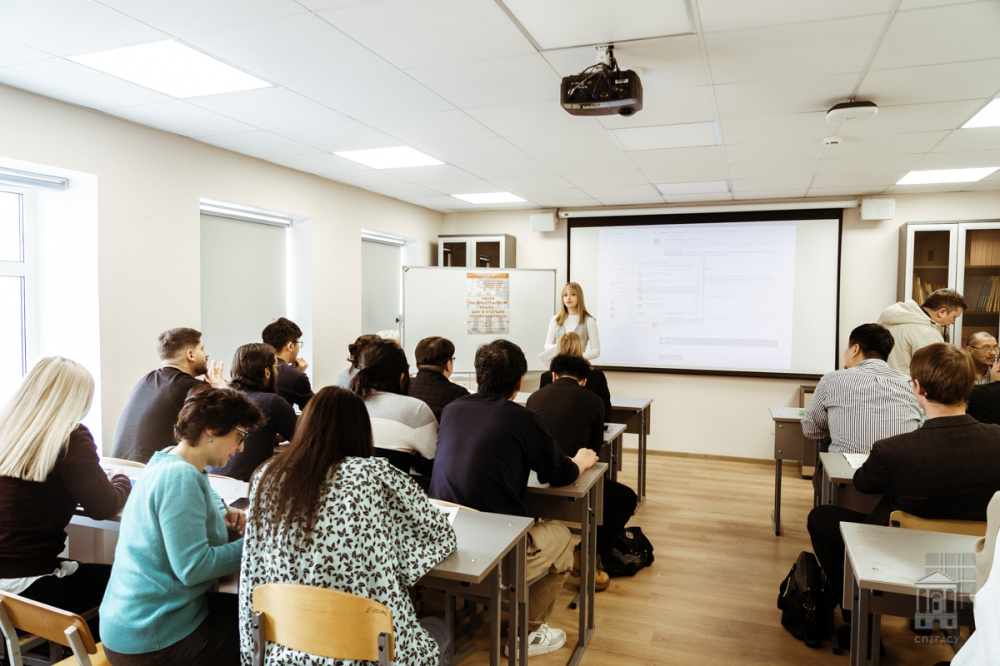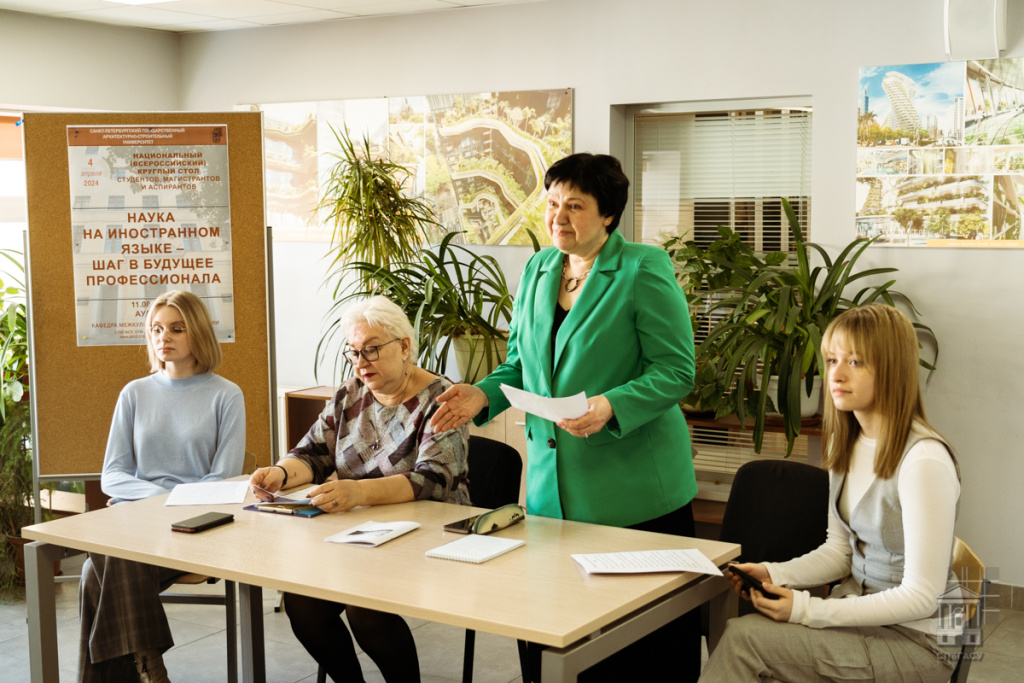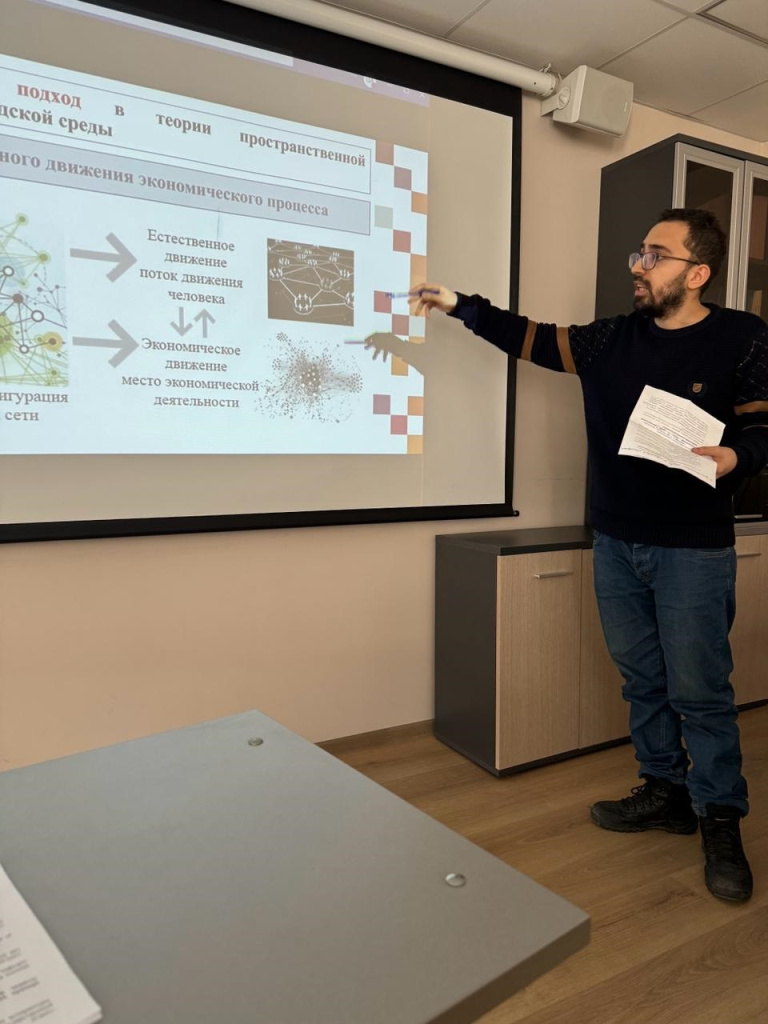 Round table, SPbGASU
Round table, SPbGASU
On April 4, SPbGASU hosted the National (All-Russian) round table “Science in a foreign language as a step into the future of a professional”. It was organized by the SPbGASU Department of Intercultural Communication.
According to Elena Selezneva, the head of the Department of Intercultural Communication, the round table became a platform for discussing issues of scientific progress and foreign languages for young researchers from St Petersburg, Nizhny Novgorod, Moscow, Omsk, Penza, Kemerovo. In addition, the event was attended by foreign PhD and master's students, as well as students of the preparatory department who have been studying Russian for only six months. Participants from Russia presented their reports in English, and foreign students - in Russian.
 From left to right: Anastasia Grebenshchikova; Professor at the SPbGASU Department of Intercultural Communication Elena Chirkova; Elena Selezneva; Sofia Myagkaya
From left to right: Anastasia Grebenshchikova; Professor at the SPbGASU Department of Intercultural Communication Elena Chirkova; Elena Selezneva; Sofia Myagkaya
The moderators were students Anastasia Grebenshchikova, Grigory Starkov, Sofia Myagkaya and Arina Parshentseva, who interacted with the section participants in two, and in some cases even in three languages.
“We are holding such an event for the third time and are glad that the number of participants is growing every year,” emphasized Elena Selezneva. “This year, more than 90 students took part in the round table.”.
The event brought together undergraduate and graduate students from different cities and universities. The event was attended by representatives of SPbGASU, St Petersburg State Forestry Engineering University, Nizhny Novgorod State University of Architecture and Civil Engineering, Mikhailovsk Military Artillery Academy, Russian University of Transport, St Petersburg State Maritime Technical University, Military Academy of Logistics (including Penza and Omsk branches), St Petersburg State University of Industrial Technologies and Design, Kemerovo State University, Russian Academy of National Economy and Public Administration. Young scientists raised interesting and important problems that they will try to solve as part of their future research.
- Section 1. Architectural and construction transformations: challenges and solutions
The reports in this section left no one indifferent. Students presented their works on various topics: from a description of the materials and structures of traditional African houses (the reports were prepared by students of the SPbGASU Preparatory Department) to a comparative analysis of the planning structure of coastal cities in Russia and precise calculations, for example, long-term resistance in compression along the fibers or elasticity in bending LVL, based on experiments carried out with one’s own hands (such work was carried out by master's students).
.jpg) Preparatory department student Elodie Dianar Rimajibay gives a presentation on “Local natural materials and their use in construction in the Republic of Chad”
Preparatory department student Elodie Dianar Rimajibay gives a presentation on “Local natural materials and their use in construction in the Republic of Chad”Katrina Tomaka, a second-year bachelor's student at the SPbGASU Faculty of Architecture, prepared a report on the use of holiday lighting to change the image of the urban environment. According to the student, it is necessary to introduce norms and standards for the design of holiday lighting installations that guarantee uniformity and visual harmony on all city streets. In addition, engaging citizens in open workshops, holding consultations to gather feedback and ideas for holiday lighting, and organizing lighting design competitions can ensure that holiday lighting becomes a key element in the approach to urban design, the author believes.
Sofya Sorokina, a second-year bachelor's student at the SPbGASU Faculty of Architecture, examined the evolution of the stylistic features of metro stations using the example of the St Petersburg metro. “When preparing for the round table, I realized how few sources of information about the St Petersburg metro are compared to the Moscow one, but it was all the more interesting to study this issue. In my report, I consider the periods of construction of the metro, which determine its appearance, how the stations and ground structures are externally connected, what cultural and social trends influenced its formation,” shared Sophya.
Sofia Chistyakova, a second-year bachelor's student at the SPbGASU Faculty of Architecture, gave a report on the development of Arctic architecture. The author examined the topic of adapting architecture to climatic and territorial Arctic conditions, turned to the history of the northern territories and the culture of local peoples, traced the development of architecture through the centuries and assessed the design progress.
Ilya Timoshin, a cadet of the Mikhailovsky Military Artillery Academy, who presented a report on the Khan’s Palace in Bakhchisarai, noted that participation in the round table inspired him to study English more seriously.
Some students took part in the round table remotely. For example, speakers from the Nizhny Novgorod State University of Architecture and Civil Engineering spoke about the architectural appearance of Samara buildings (Evgeny Portey), the process of mixing reagents with water (Daniil Kostin) and how architects create a metaverse (Tatiana Volkova).
 PhD student Majd Tazhir
PhD student Majd Tazhir- Section 2. Economy in an era of change: challenges and prospects
According to the organizers, this section was distinguished by the varied topics of the reports. Young researchers talked about artificial intelligence, discussed issues of urban planning and architecture, conducted a comparative analysis of the preservation of Russian and Chinese architectural heritage, compared the weapons of NATO countries and Russia, as well as the higher education systems in Syria and Russia.
A wide range of topics, from weapons to marketing and architecture, were covered by cadets of the Mikhailovsky Military Artillery Academy.
The report of Roman Loktevich, an SPbGASU second-year master's student, on the use of waste in road construction evoked a great response. Some presentations were truly innovative: for example, SPbGASU PhD student Majd Tazhur introduced listeners to his own spatial theory of social approach in the urban environment.
Viktoria Fefelova and Maria Cherkashina, second-year bachelor's students at the SPbGASU Faculty of Economics and Management, presented a report on the role and relationship of TIM (information modeling technologies) and modern innovations and macroeconomic indicators. The students noted that TIM is a special tool for studying the impact of new technologies on economic growth and labor productivity.
Vladislav Tikkoev, a first-year master's student at the Faculty of Economics and Management, in his report highlighted the importance of consulting services in the construction field: in his opinion, they contribute to the development of projects, improvement of internal processes and optimization of resources. After the event, Vladislav shared his impressions: “Of course, I haven’t publicly given a report in English for a long time. But the experience, it seems to me, is very useful. If there are more similar events, I will gladly participate.”
Timofey Elagin, a second-year specialist's student of the SPbGASU Faculty of Automobile and Road Building, spoke about the potential risks and problems of the unalternative implementation of artificial intelligence systems and digital technologies in the main areas of human activity. The author of the report paid main attention to personal data (including biometric), the introduction of electronic signatures, the use of AI systems in educational activities, in medicine, as well as legal and ethical problems. Timofey came to the conclusion that with the mass introduction of digital technologies and AI systems into life, it is necessary to leave room for traditional means, proven by the experience and knowledge of previous generations, and continue to develop them. Digitalization should not be carried out for the sake of digitalization. Digital systems should be man's assistants, not his leaders.
Ivan Beshentsev, a second-year bachelor's student at the SPbGASU Faculty of Automobile and Road Building, examined the historical path of development of electric transport in St Petersburg. During the internship, Ivan became familiar with data on transport surveys of trams and trolleybuses from 1925 to 1987. These data made it possible to study the Soviet approach to organizing the transport system of Leningrad and formed the basis for an article for the round table. The student is sure: today in the Northern capital the need for modern urban transport is growing with every new resident and, even more so, with every new building built in any district of the city.
“We must remember the heroic exploits of tram drivers during the difficult years of the siege, and popularize the works of great tram scientists. For example, Abram Zilbertal, whose manuals are the most detailed and honest description of the organization of tram traffic in cities. He predicted many of today's transport problems back in the 1930s. My article talks about the development of the electric transport complex in the city on the Neva, and about how we became the tram capital of the world with an effective addition in the form of a trolleybus, and why exactly this way, and no other way, today we need to develop urban electric transport,” noted Ivan.
- Section 3. Intercultural communication, language interaction and translation practice
This section was devoted to issues of automated translation, lexical and grammatical features, adequacy and equivalence of translation, issues of military-technical translation, as well as problems of intercultural communication and ethnopsychology. The section was attended by SPbGASU students, invited guests from other universities, students and graduates of the program “Translator in the field of professional activity”.
Issues of language and translation activities in the field of professional communication were highlighted by Sofya Kosova, a third-year bachelor's student at the SPbGASU Faculty of Civil Engineering. To gain more knowledge in their professional field, students often turn to resources from the English-speaking segment. But the question arises: what to do for those whose level of English is not high enough to study the material in the original? Can they use automated translation systems as an alternative without fear of receiving text that differs in meaning from the original? Sofya Kosova described the features of translating scientific and technical texts and the difficulties that arise in the process of working with such materials, reviewed the theoretical foundations of machine translation, developments in the field of machine translation systems, and also analyzed the advantages and disadvantages of such systems.
Vladislava Savelyeva, a fourth-year bachelor's student at the Faculty of Architecture, presented a report on the lexical difficulties of translating texts on architectural topics. The author examined various types of architectural terms, ways to achieve adequacy in their translation and the lexical transformations used for this; revealed the difficulties that a translator faces when working with texts on this profile. “Perhaps the biggest challenge is the interdisciplinarity of architecture in general and, therefore, the use of terminology from a wide variety of fields: from history and sociology to foundation engineering. To write the article, I wanted to take a topic that would be relevant and useful,” said Vladislava Savelyeva.
Ivan Zaitsev, a second-year specialist's student at the Faculty of Civil Engineering, investigated the difficulties of translating names and descriptions of specialized materials produced abroad. The report raised the question of the equivalence of translation of terminology in the construction industry, provided examples of terms from construction texts with translations into Russian, and analyzed each of the possible options.
“I have been studying this topic relatively recently - I am a second-year student. However, I already experienced some difficulties understanding certain construction terms and concepts in English,” said Ivan. According to the student, the main obstacles include localization problems, grammatical and stylistic differences between languages, and the translator’s lack of knowledge about the technical properties or scope of the material.